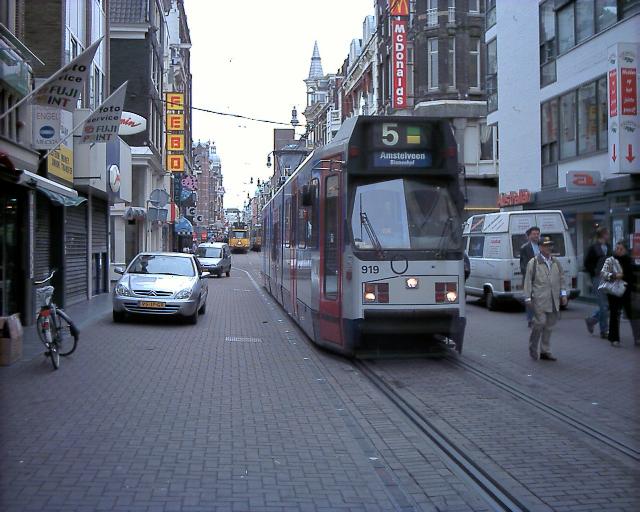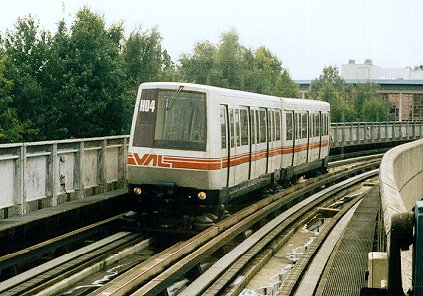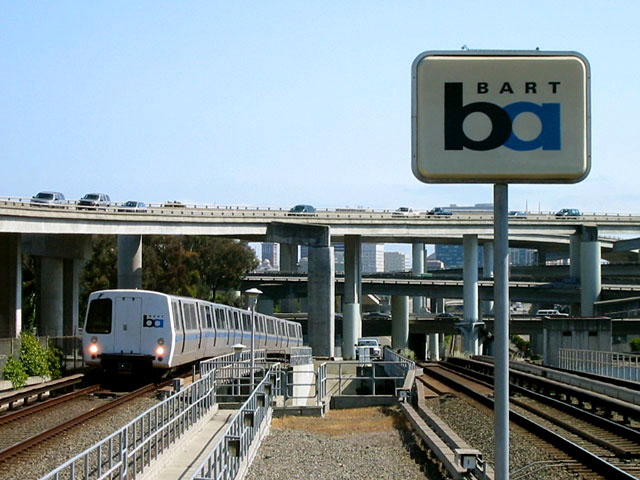Hipster Duck
Senior Member
I was hoping we could have an illustrated dictionary of the different transit modes out there so that when we talk about something, we avoid confusion (Eg: No more confusing S-bahn/RER/regional rail with LRTs!). Feel free to add to this like a wiki article.
Category 1: Buses
Bus
Just your standard, run-of-the-mill city bus.

Examples
anywhere.
Variations: Trolley bus, articulated bus, double decker bus
-----
Bus on Express Route
A regular bus that runs along an express variant of a regular route, or a short-distance point-to-point route, often connecting a distant suburban area to the central transit network or transport nodes together. Often have limited service hours. May run on expressways for some periods, and can use designated HOV lanes.

Examples
TTC "E" routes (35E, 39E, 96E)
190 series Rocket Routes
Mississauga Transit 100 and 200 series routes
Quality Express Bus
A bus with some perks, such as queue jump lanes, ticketing machines and a greater distance between stops. Often branded differently from regular city buses to connote a premium service. No separated right of ways (ROW). Uses advanced stops, but not actual stations.

Examples
VIVA
Brampton Zum
GRT iXpress
LA Metro 700-series Rapid Routes
---
Bus Rapid Transit (BRT)
Buses running in dedicated ROWs (aka: a busway) stopping only at designated stations that are built like rapid transit stations.


Examples
Ottawa Transitway
Winnipeg RT
LA Metro Orange Line
Bogota TransMilenio
BRT system in Curitiba, Brazil
U/C Mississauga Busway
---
Inter-regional coach buses
Uses coach buses to serve commuters in far-flung exurban regions, or for intra-regional suburban travel along highways between nodes.

Examples
GO bus service
MTA long distance bus service (New York)
Greyhound QuickLink commuter service
===============================================
Category 2: Light Rail systems
Streetcars
Streetcars are single or articulated light rail vehicles that run in mixed urban traffic and are typically fed by overhead catenary at a lower voltage. Before the advent of city buses, streetcars were used in almost every North American city of any size and, indeed, in just about all developed countries at the time. Beginning in the 1930s and reaching a crescendo in the 1950s, almost every city in North America, and many in Western Europe, Japan, China and Australia began abandoning streetcars in favour of city buses as the workhorses of their public transit system.
Variation A: Heritage tramway/trolley
Typically used as a tourist-oriented route, as a start-up, or as a gentrification or development scheme. Uses real or replica historical vehicles on a short, urban operation that is almost always a new or long-abandoned route. Unlike a transit museum, it is part of the local transit system and carries point-to-point passengers. Most common in North America, but elsewhere (Istanbul "nostalgic trams" are a great example of non-NA re-installation of a heritage tram). Examples: Nelson, BC; Edmonton Heritage Streetcar; Old Pueblo Trolley in Tuscon, AZ; Tampa; Memphis; Kenosha.
Variation B: Modern Streetcar
Used as a development tool, like a heritage tram, but with modern equipment on a new, modern alignment. Differs from a light rail system in terms of stop spacing (usually every one or two blocks), vehicle size and route length.
The prime North American example is the Portland Streetcar, but the South Lake Union Trolley in Seattle is another good example. Arguably, the 509 here in Toronto could qualify as it is a new route meant to serve waterfront development.
Variation C: Legacy Street Railway
A classic streetcar operation in continuous operation, with street running. Abandonment not carried out for reasons of cost or practicality (terrain, a tunnel segment, politics). Can be confused for a heritage tramway when older vehicles are used, such as Melbourne or Hong Kong. Examples: Toronto Streetcars, SEPTA Subway-Surface lines, New Orleans Charles St Streetcar, SEPTA (Philly) 15-Girard PCC route.
The Muni F Market and Wharves Route and New Orleans streetcars manage to fall under variations A & C they are partially legacy routes and operate with vintage (MUNI F and NORTA St. Charles Ave) and replica (in the case of NORTA's Canal Street and Waterfront Lines).
Example


Examples (surviving)
Toronto streetcar
Melbourne tram
Amsterdam tram
Zurich tram
Hong Kong Tramways
---
Light Rail Transit (LRT) Version 1: Light Rail
Light rail transit was a word that was coined to describe an adaptation of streetcar technology for rapid transit. LRT can come in two forms: the first I will just call "light rail" and the second I will term "Pre Metro". Light Rail in the former case typically involves low-floor streetcars that are articulated but not much larger than a TTC streetcar traveling in separated ROWs with simple station infrastructure (typically low platforms and a minimum of amenities). There are many examples of this throughout the world and increasingly in North America. In some cities in the US, light rail stations are fairly advanced while, in others, notably San Francisco's Muni Metro and Boston's MBTA Green Line, stations are scarcely more than longer transit shelters. If the Spadina or St. Clair streetcar lines used more modern streetcar equipment you could adequately term these lines to be "light rail", although in almost all other cities light rail has signaling priority over other traffic on the road. Transit City, if built, would mostly resemble this form of transit.
It's interesting to note that Light Rail is not a new idea. Many US cities, such as the aforementioned San Francisco and Boston, as well as Pittsburgh, Cleveland, Philadelphia and Newark used PCC streetcars to run a rapid service on grade separated ROWs well before the war. In many ways, the portion of the 501 streetcar that runs along the Queensway here in Toronto is an LRT line in this vein.


examples
Houston METROrail
Portland MAX
Baltimore LRT
San Francisco MUNI Metro
Manchester Metrolink
Strasbourg tram
---
LRT Version 2: Pre-Metros
I use the word "pre metro" to distinguish this form of LRT from its more simple cousin.
A pre metro is a true rapid transit line that uses coupled light rail vehicles. In many cities, this may substitute for a subway because it has a fairly high capacity and offers good speed at less capital cost than building a subway or elevated rail line. I think the best way to tell that it's a pre metro is that, although it uses streetcars, you would never dream of running these suckers on the street. In fact, when they cross the road, signals start flashing and barrier gates come down as if a freight train were about to barrel through.
Here in Canada, we have two very good examples of Pre Metro LRTs in Edmonton and Calgary. Outside of the downtown core, these lines run in their own corridors, usually beside rail lines, and have real high platform stations that aren't far removed from surface subway stations here in Toronto such as those along the Allen or Rosedale. In the core, they either dip underground like a subway (Edmonton) or run in a closed-off street that is inaccessible to both cars or pedestrians (Calgary). Note that the size of these trains has led politicians in Calgary to consider tunneling the downtown portion of the C-train route.

[u]Examples[/u]
Edmonton LRT
Calgary C-train
LA Metro: Green, Blue and Gold lines
Tyne and Wear Metro (Newcastle, UK)
Stuttgart U-bahn
Frankfurt U-bahn
St. Louis MetroLink
Planned Ottawa LRT
---
Okay, I have to go back to work, but we will be back with examples of heavy rail systems: subways, S-bahns, commuter rail and intercity rail!
As I said: Please feel free to modify this post like a wiki article if you're a mod and, if you're not, then post your corrections, feedback and additional insights below and maybe the mods can add it in.
Category 1: Buses
Bus
Just your standard, run-of-the-mill city bus.

Examples
anywhere.
Variations: Trolley bus, articulated bus, double decker bus
-----
Bus on Express Route
A regular bus that runs along an express variant of a regular route, or a short-distance point-to-point route, often connecting a distant suburban area to the central transit network or transport nodes together. Often have limited service hours. May run on expressways for some periods, and can use designated HOV lanes.

Examples
TTC "E" routes (35E, 39E, 96E)
190 series Rocket Routes
Mississauga Transit 100 and 200 series routes
Quality Express Bus
A bus with some perks, such as queue jump lanes, ticketing machines and a greater distance between stops. Often branded differently from regular city buses to connote a premium service. No separated right of ways (ROW). Uses advanced stops, but not actual stations.

Examples
VIVA
Brampton Zum
GRT iXpress
LA Metro 700-series Rapid Routes
---
Bus Rapid Transit (BRT)
Buses running in dedicated ROWs (aka: a busway) stopping only at designated stations that are built like rapid transit stations.


Examples
Ottawa Transitway
Winnipeg RT
LA Metro Orange Line
Bogota TransMilenio
BRT system in Curitiba, Brazil
U/C Mississauga Busway
---
Inter-regional coach buses
Uses coach buses to serve commuters in far-flung exurban regions, or for intra-regional suburban travel along highways between nodes.

Examples
GO bus service
MTA long distance bus service (New York)
Greyhound QuickLink commuter service
===============================================
Category 2: Light Rail systems
Streetcars
Streetcars are single or articulated light rail vehicles that run in mixed urban traffic and are typically fed by overhead catenary at a lower voltage. Before the advent of city buses, streetcars were used in almost every North American city of any size and, indeed, in just about all developed countries at the time. Beginning in the 1930s and reaching a crescendo in the 1950s, almost every city in North America, and many in Western Europe, Japan, China and Australia began abandoning streetcars in favour of city buses as the workhorses of their public transit system.
Variation A: Heritage tramway/trolley
Typically used as a tourist-oriented route, as a start-up, or as a gentrification or development scheme. Uses real or replica historical vehicles on a short, urban operation that is almost always a new or long-abandoned route. Unlike a transit museum, it is part of the local transit system and carries point-to-point passengers. Most common in North America, but elsewhere (Istanbul "nostalgic trams" are a great example of non-NA re-installation of a heritage tram). Examples: Nelson, BC; Edmonton Heritage Streetcar; Old Pueblo Trolley in Tuscon, AZ; Tampa; Memphis; Kenosha.
Variation B: Modern Streetcar
Used as a development tool, like a heritage tram, but with modern equipment on a new, modern alignment. Differs from a light rail system in terms of stop spacing (usually every one or two blocks), vehicle size and route length.
The prime North American example is the Portland Streetcar, but the South Lake Union Trolley in Seattle is another good example. Arguably, the 509 here in Toronto could qualify as it is a new route meant to serve waterfront development.
Variation C: Legacy Street Railway
A classic streetcar operation in continuous operation, with street running. Abandonment not carried out for reasons of cost or practicality (terrain, a tunnel segment, politics). Can be confused for a heritage tramway when older vehicles are used, such as Melbourne or Hong Kong. Examples: Toronto Streetcars, SEPTA Subway-Surface lines, New Orleans Charles St Streetcar, SEPTA (Philly) 15-Girard PCC route.
The Muni F Market and Wharves Route and New Orleans streetcars manage to fall under variations A & C they are partially legacy routes and operate with vintage (MUNI F and NORTA St. Charles Ave) and replica (in the case of NORTA's Canal Street and Waterfront Lines).
Example


Examples (surviving)
Toronto streetcar
Melbourne tram
Amsterdam tram
Zurich tram
Hong Kong Tramways
---
Light Rail Transit (LRT) Version 1: Light Rail
Light rail transit was a word that was coined to describe an adaptation of streetcar technology for rapid transit. LRT can come in two forms: the first I will just call "light rail" and the second I will term "Pre Metro". Light Rail in the former case typically involves low-floor streetcars that are articulated but not much larger than a TTC streetcar traveling in separated ROWs with simple station infrastructure (typically low platforms and a minimum of amenities). There are many examples of this throughout the world and increasingly in North America. In some cities in the US, light rail stations are fairly advanced while, in others, notably San Francisco's Muni Metro and Boston's MBTA Green Line, stations are scarcely more than longer transit shelters. If the Spadina or St. Clair streetcar lines used more modern streetcar equipment you could adequately term these lines to be "light rail", although in almost all other cities light rail has signaling priority over other traffic on the road. Transit City, if built, would mostly resemble this form of transit.
It's interesting to note that Light Rail is not a new idea. Many US cities, such as the aforementioned San Francisco and Boston, as well as Pittsburgh, Cleveland, Philadelphia and Newark used PCC streetcars to run a rapid service on grade separated ROWs well before the war. In many ways, the portion of the 501 streetcar that runs along the Queensway here in Toronto is an LRT line in this vein.


examples
Houston METROrail
Portland MAX
Baltimore LRT
San Francisco MUNI Metro
Manchester Metrolink
Strasbourg tram
---
LRT Version 2: Pre-Metros
I use the word "pre metro" to distinguish this form of LRT from its more simple cousin.
A pre metro is a true rapid transit line that uses coupled light rail vehicles. In many cities, this may substitute for a subway because it has a fairly high capacity and offers good speed at less capital cost than building a subway or elevated rail line. I think the best way to tell that it's a pre metro is that, although it uses streetcars, you would never dream of running these suckers on the street. In fact, when they cross the road, signals start flashing and barrier gates come down as if a freight train were about to barrel through.
Here in Canada, we have two very good examples of Pre Metro LRTs in Edmonton and Calgary. Outside of the downtown core, these lines run in their own corridors, usually beside rail lines, and have real high platform stations that aren't far removed from surface subway stations here in Toronto such as those along the Allen or Rosedale. In the core, they either dip underground like a subway (Edmonton) or run in a closed-off street that is inaccessible to both cars or pedestrians (Calgary). Note that the size of these trains has led politicians in Calgary to consider tunneling the downtown portion of the C-train route.

[u]Examples[/u]
Edmonton LRT
Calgary C-train
LA Metro: Green, Blue and Gold lines
Tyne and Wear Metro (Newcastle, UK)
Stuttgart U-bahn
Frankfurt U-bahn
St. Louis MetroLink
Planned Ottawa LRT
---
Okay, I have to go back to work, but we will be back with examples of heavy rail systems: subways, S-bahns, commuter rail and intercity rail!
As I said: Please feel free to modify this post like a wiki article if you're a mod and, if you're not, then post your corrections, feedback and additional insights below and maybe the mods can add it in.
Last edited by a moderator:













